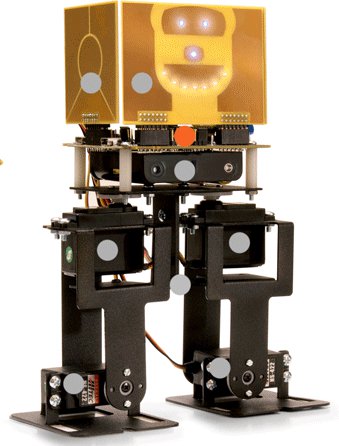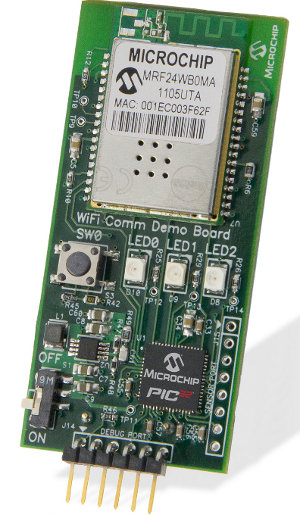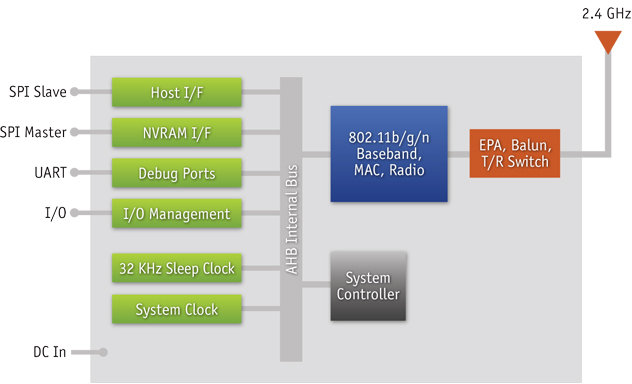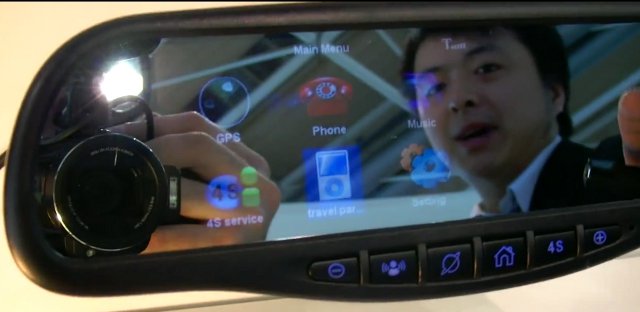Freescale unveiled the FSLBOT prototype last year (and I missed it!), and today, the company has announced further improvements to the Freescale Tower System mechatronics robot and board, a bipedal robot and development board that allows designers to write software for a variety of sensor applications while making a robot walk and respond to touch, motion, vibration, tilt and other external stimuli. The new version of the robot uses a new programming language based on StickOS, has wireless capabilities and adds an Xtrinsic MAG3110 magnetometer. This robot has been designed with the collaboration of StickOS and CPUStick.com with the goal “to create a tool that would enable casual users and consumers of technology to become creators and innovators”. The Freescale FSLBOT Robot Kit comes with the following: Freescale Tower System mechatronics board powered by a 32-bit ColdFire MCU with 64K of RAM and 512K of flash. Leg mechanics and associated […]
Microchip Unveils Wi-Fi Comm Demo Board with 32-bit PIC32 MCU
After TI and Qualcomm, here’s another WiFi solution for MCU aimed at the internet of things (IoT). Yesterday, Microchip Technology announced the Wi-Fi Comm Demo Board, which combines a Microchip 32-bit PIC32 microcontroller (PIC32MX695F512H) with a low-power MRF24WB0MA embedded Wi-Fi radio transceiver module. This small (and cheap) demo board can be used to integrate with existing embedded designs and/or to evaluate Wi-Fi connectivity with a 32-bit MCU. Contrary to TI and Qualcomm, the IP network stack is not implemented in hardware, but Microchip provides a TCP/IP stack that can be freely downloaded at http://www.microchip.com/get/A3VP. This TCP/IP stack includes HTML, DHCP, DNS, IPv4/v6, SSL, etc… (See diagram below) The memory footprint is 28-34 KB depending on the modules used. I could not find details about power consumption, but the company claims their solution can also run with just 2 AAA batteries. Microchip explains that this solution can enable the rapid growth […]
Qualcomm Atheros AR4100P Provides WiFi Connectivity to the Internet of Things
In January, Texas Instruments was the first company (to my knowledge) to release a WiFi chip for the internet of things, the SimpleLink Wi-Fi CC3000, where WiFi is mostly implemented in hardware to lower power consumption. Now, the company has some competition with the announcement of Qualcomm Atheros AR4100P, an improved version of its AP4100 WiFi chipset, including IPv4/IPv6 support. The AR4100 targets the home, enterprise, smart grid and home automation and control applications that have lower data rates and transmit or receive data on an infrequent basis. The AR4100 system-in-package (SIP) features the following: Low energy Power saving modes as low as 5 µA Wake-up times as low as 2.2 ms Support for Quad SPI flash for faster wake times Low system resource requirements Low footprint host driver (25K Flash and 8K RAM) Simple, low-cost wireless system integration LGA package simplifies 2- or 4-layer PCB design Near zero RBOM […]
98 Raspberry Pi Boards Left for Qt Developers
In November 2011, the Raspberry Pi foundation announced that Nokia purchased codes for 400 boards from the 1st 10,000 batch, in order to give them away to selected developers that are interested in helping develop and test Qt 5 on the Raspberry Pi. This developer program is called QtonPi. The surprising part if that they struggle to distribute all those boards. Although to date 425 people have been selected, only 302 are currently eligible to receive a board because over 100 developers did not provide their details to receive the free Raspberry Pi board namely: Their full name The link to their wiki user profile. The area of the “QtonPi Accepted Page” where they are listed. The country where the board will be shipped If by chance, you are reading this blog, have been selected but you can’t see “OK” or “CODE SENT” next to your user ID, you should […]
Archos G10 xs Teaser Video with Sliding Keyboard Dock
Archos has just released a teaser video for its next generation Android tablet, the Archos G10 xs (xs stands for extra small). The video does not show much, except the concept of the new tablet which features a sliding keyboard where the tablet can be docked. Archos has not released the specifications for the G10 XS yet, but we do know the casing is made of stainless steel, is 7.6mm thick (12mm with the keyboard) and Archos has worked for 3 years on this design. There will be several models whose retail price should be between 200 and 300 Euros (Which would be between 200 and 300 USD in the US thanks to lower taxes). The new tablets will be powered by a Texas Instruments processor (probably OMAP 4) like the Archos G9 tablets and run Android 4.0 and Windows 8 depending on the model. Jean-Luc Aufranc (CNXSoft)Jean-Luc started CNX […]
Designing An Android Sensor Subsystem: Pitfalls and Considerations – Android Builder Summit 2012
Jen Costillo of Lab 126 discusses the Android sensor subsystem at the Android Builder Summit in February 2012. Abstract: This lecture will arm Android device architects with the tactical knowledge they need to navigate the Android Sensor subsystem and make knowledgeable design choices to improve user experience and improve battery performance. The talk will address: Hardware architecture and trade-offs including latency, power, and software architecture implications: Wake up events and power considerations Gesture Detection Algorithm processing location and considerations Testing methodologies (Creating tools to aid develop and collect data. This talk targets the kernel/firmware developer responsible for the sensor architecture. They should be familiar with kernel drivers, embedded systems, hardware bring up, Android services, and the C language. You can also download the presentation slides on linuxfoundation.org website. Jean-Luc Aufranc (CNXSoft)Jean-Luc started CNX Software in 2010 as a part-time endeavor, before quitting his job as a software engineering manager, and […]
Shenzhen Wabook EPC1029 ARM Netbook Runs Android 2.3 / 4.0
Shenzhen Wabook Technology, a manufacturer with a factory based in Zhuhai, China, showcases their Wabook Netbook at Cebit 2012. The Wabook EPC1029 is a netbook running Android 2.3 (upgradable to Android 4.0) on a Rockchip RK2918 (ARM Cortex A8) @ 1.0 GHz. The device features a 10.1″ TFT LED display (16:9 aspect ratio) with a resolution of 1024×600, 3 USB host ports, Ethernet. No other technical specs are available yet. Only Android is available, but it might be possible to hack Ubuntu or another distro to run on it. You can watch the video below by Charbax of armdevices.net to see the device. Don’t worry pink is not the only color as white and black are also available. The price for 1,000 pieces (MOQ) is 93 USD and it takes around 25-30 days to get your order. They have already sold tens of thousands to a company in France. With […]
Huawei M2M Solutions: Android Rear-View Mirror, Smart Grid and more
Huawei is exhibiting their Machine to Machine (M2M) solutions at Cebit 2012 until March 10, 2012. They are showcasing Smart Meter solutions with home energy gateways, smart gas meters, smart electric meters, in-home displays.. all communicating via Zigbee. Their solution is currently being implement in the UK market. They are also exhibiting diverse modules (mainly based on Freescale i.MX5 processor) featuring Huawei 3G technology that could be used in tablets among other things. But the thing is really found interesting was their M2M solutions for the auto industry especially the Android car rear-view mirror where you can have the left half of the rear-view mirror displaying a menu so that you can access apps such as GPS maps, control your music or your phone and see information about your car. Here are some details above this rear-view mirror: Samsung SP5V210 Cortex A8 Processor 4.3″ TFT capacitive touchscreen – Resolution: 800×480 […]







